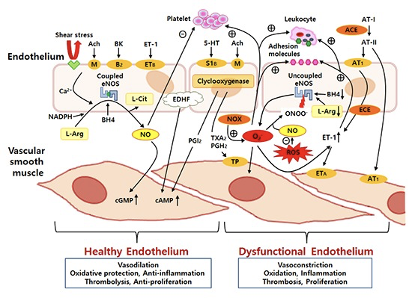Nitric Oxide & The Endothelium
Dicken Weatherby, N.D. and Beth Ellen DiLuglio, MS, RDN, LDN
A healthy endothelium is characterized by reduced vascular tension and low oxidative stress… a state that is maintained by bioactive mediators including nitric oxide (NO).The Endothelial Dysfunction Series
- Endothelial Dysfunction part 1 - An Overview
- Endothelial Dysfunction part 2 - The Endothelium
- Endothelial Dysfunction part 3 - Nitric Oxide
- Endothelial Dysfunction part 4 - Diseases and Causes
- Endothelial Dysfunction part 5 - Immune Response & Oxidative Stress
- Endothelial Dysfunction part 6 - Atherosclerosis
- Endothelial Dysfunction part 7 - Assessment Part 1
- Endothelial Dysfunction part 8 - Assessment part 2
- Endothelial Dysfunction part 9 - Functional Naturopathic Approach
- Endothelial Dysfunction part 10 - Optimal Takeaways
Disruption of this blood vessel bliss by noxious stimuli will cause endothelial dysfunction… laying the groundwork for atherosclerosis and blood vessel damage.
Decreased availability or function of NO in particular contributes to most endothelial dysfunction, and therefore the majority of cardiovascular disease.[i] [ii] [iii]

“An overview of the effects of vascular endothelial factors on the function of vascular smooth muscle and circulating blood cells. In the healthy endothelium, the eNOS is responsible for most of the vascular NO production. However, eNOS becomes a potential ROS generator when in the pathological uncoupled state, due to various oxidative stresses. ACE, angiotensin-converting enzyme; Ach, acetylcholine; AT-I, angiotensin I; AT-II, angiotensin II; AT1, angiotensin 1 receptor; BH4, tetrahydrobiopterin; BK, bradykinin; cAMP, cyclic adenosine monophosphate; cGMP, cyclic guanosine monophosphate; ECE, endothelin converting enzyme; eNOS, endothelial nitric oxide synthase; EDHF, endothelium derived hyperpolarizing factor; ETA and ETB, endothelin A and B receptors; ET-1, endothelin-1; L-Arg, L-arginine; L-Cit, L-citrulline; M, muscarinic receptor; O2-, superoxide anion; ONOO-, peroxynitrite; NADPH, nicotinamide adenine dinucleotide phosphate; NO, nitric oxide; NOX, nicotinamide adenine dinucleotide phosphate oxidase; PGH2, prostaglandin H2; PGI2, prostaglandin I2; ROS, reactive oxygen species; S1B, serotonin receptor; TP, thromboxane prostanoid receptor; TXA2, thromboxane; 5-HT, serotonin; Θ, inhibition; ⊕, stimulation.”
Source: Park, Kyoung-Ha, and Woo Jung Park. “Endothelial Dysfunction: Clinical Implications in Cardiovascular Disease and Therapeutic Approaches.” Journal of Korean medical science vol. 30,9 (2015): 1213-25. This is an Open Access article distributed under the terms of the Creative Commons Attribution Non-Commercial License, which permits unrestricted non-commercial use, distribution, and reproduction in any medium, provided the original work is properly cited.
Nitric oxide is the keystone to endothelial homeostasis. It is derived from the conditionally essential amino acid arginine through the action of endothelial nitric oxide synthase and the influence of factors such as chemical agonists and shear stress.[iv]
Nitric oxide has a protective effect on the endothelium through facilitation of vasodilation, platelet stabilization, inhibition of smooth muscle migration/hyperplasia, and maintenance of an anti-inflammatory milieu.[v]
Specifically, nitric oxide inhibits:[vi]
- Inflammation
- Leukocyte adhesion
- Oxidative stress
- Platelet aggregation
- Vascular smooth muscle cell migration and proliferation
However, once the endothelium is damaged, the protective effects of nitric oxide dissipate.[vii] The damaged area is very susceptible to fibrosis, lipid deposition, and infiltration of inflammatory immune cells.[viii]
NEXT UP - Endothelial Dysfunction part 4 - Diseases and Causes
Research
[i] Sitia, S et al. “From endothelial dysfunction to atherosclerosis.” Autoimmunity reviews vol. 9,12 (2010): 830-4.
[ii] Félétou, Michel. The Endothelium: Part 1: Multiple Functions of the Endothelial Cells—Focus on Endothelium-Derived Vasoactive Mediators. Morgan & Claypool Life Sciences, 2011.
[iii] Félétou, Michel. The Endothelium: Part 1: Multiple Functions of the Endothelial Cells—Focus on Endothelium-Derived Vasoactive Mediators. Morgan & Claypool Life Sciences, 2011.
[iv] Park, Kyoung-Ha, and Woo Jung Park. “Endothelial Dysfunction: Clinical Implications in Cardiovascular Disease and Therapeutic Approaches.” Journal of Korean medical science vol. 30,9 (2015): 1213-25.
[v] Plotnick, Gary D et al. “Effect of supplemental phytonutrients on impairment of the flow-mediated brachial artery vasoactivity after a single high-fat meal.” Journal of the American College of Cardiology vol. 41,10 (2003): 1744-9. [vi] Park, Kyoung-Ha, and Woo Jung Park. “Endothelial Dysfunction: Clinical Implications in Cardiovascular Disease and Therapeutic Approaches.” Journal of Korean medical science vol. 30,9 (2015): 1213-25.
[vii] Al-Qaisi, Mo et al. “Measurement of endothelial function and its clinical utility for cardiovascular risk.” Vascular health and risk management vol. 4,3 (2008): 647-52.
[viii] Al-Qaisi, Mo et al. “Measurement of endothelial function and its clinical utility for cardiovascular risk.” Vascular health and risk management vol. 4,3 (2008): 647-52.






